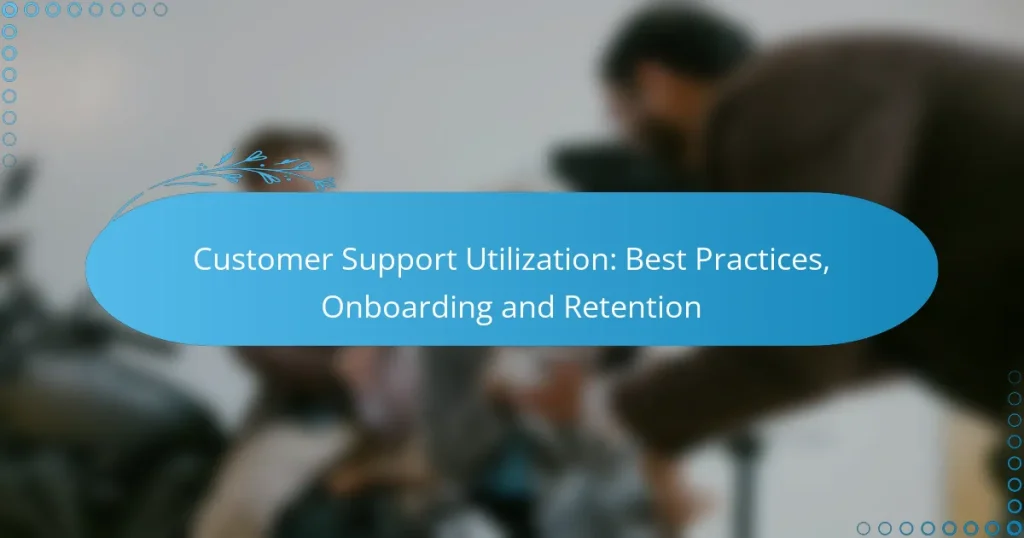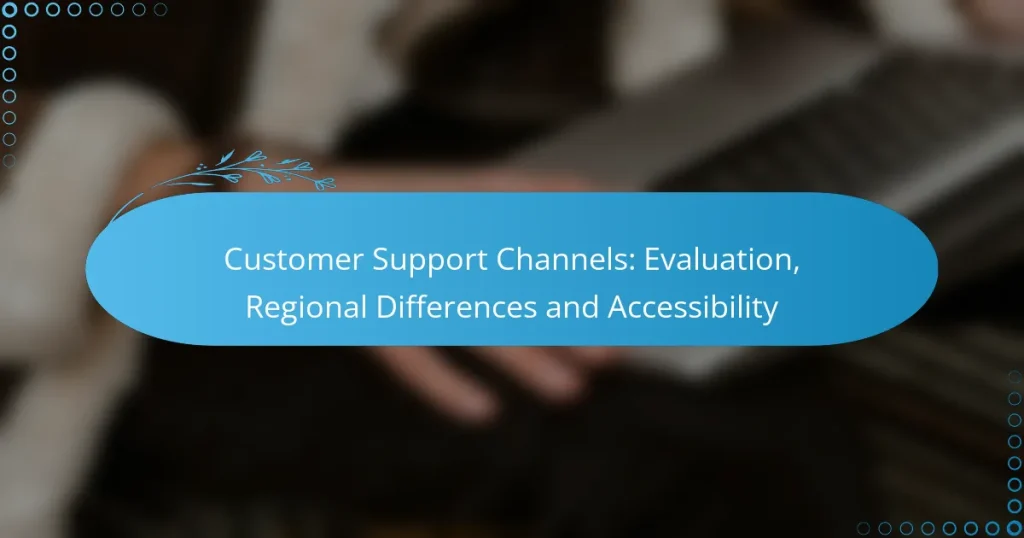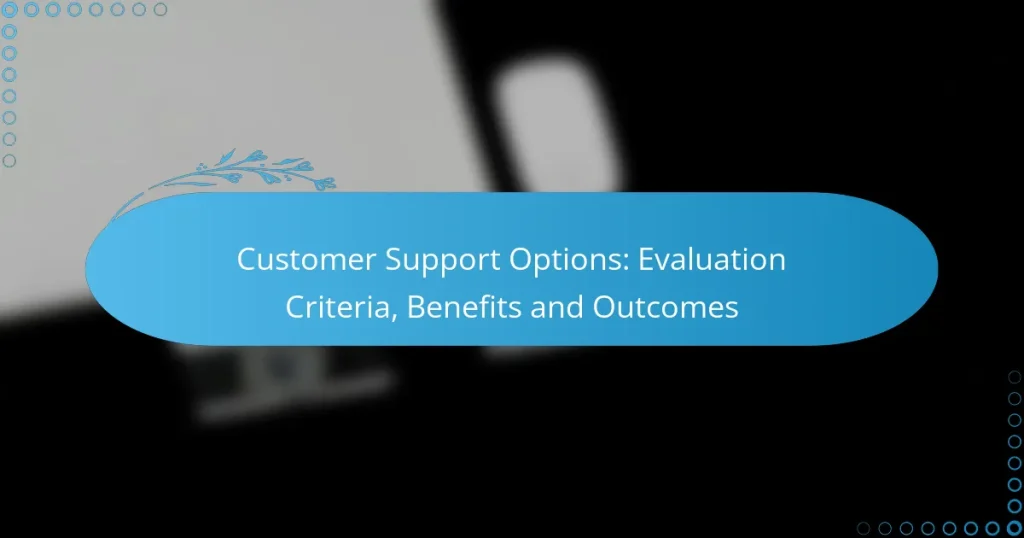In the competitive landscape of SaaS businesses, effective customer support is crucial for success. Utilizing specialized tools can significantly enhance communication, streamline ticket management, and provide valuable insights through analytics. By investing in the right customer support platforms, companies can improve response times and overall customer satisfaction, ensuring a positive experience for their users.
24/7 Customer Support: Importance, Benefits and User Satisfaction
Customer Support Utilization: Best Practices, Onboarding and Retention
Customer Support Channels: Evaluation, Regional Differences and Accessibility
Live Chat Support Features: Comparison, Benefits and User Experience
Customer Support Options: Evaluation Criteria, Benefits and Outcomes
What are the best customer support tools for SaaS businesses in the UK?
The best customer support tools for SaaS businesses in the UK include platforms that enhance communication, streamline ticket management, and provide analytics. Key options like Zendesk, Freshdesk, Intercom, Help Scout, and LiveAgent each offer unique features tailored to different business needs.
Zendesk
Zendesk is a widely used customer support tool that offers a comprehensive suite of features, including ticketing, live chat, and a knowledge base. Its user-friendly interface allows teams to manage customer inquiries efficiently, making it suitable for both small and large SaaS businesses.
Consider its scalability; Zendesk can grow with your business, accommodating increasing ticket volumes and additional features as needed. Pricing typically starts at around £5 per agent per month, making it accessible for various budgets.
Freshdesk
Freshdesk provides a robust platform for customer support with features such as multi-channel support, automation, and reporting tools. Its intuitive design helps teams respond to customer queries quickly, which is crucial for maintaining customer satisfaction in the SaaS sector.
One of Freshdesk’s standout features is its gamification element, which encourages team performance through rewards. Pricing starts at approximately £15 per agent per month, offering a good balance of features for the cost.
Intercom
Intercom focuses on conversational support, enabling real-time communication through chatbots and messaging. This tool is particularly effective for SaaS businesses looking to engage users proactively and provide immediate assistance.
Intercom’s pricing is usage-based, which can be beneficial for businesses with fluctuating support needs. However, it may become costly as your user base grows, so it’s essential to evaluate your long-term support strategy before committing.
Help Scout
Help Scout is designed for teams that prioritize personal customer interactions. It features a shared inbox, knowledge base, and reporting tools, all aimed at creating a seamless support experience. This tool is particularly well-suited for smaller SaaS companies that want to maintain a personal touch.
Help Scout’s pricing starts at around £15 per user per month, making it a cost-effective choice for teams focused on quality over quantity in customer interactions.
LiveAgent
LiveAgent offers a multi-channel support system that integrates live chat, email, and social media inquiries into one platform. This tool is ideal for SaaS businesses that require a centralized system to manage customer interactions across various channels.
With a pricing model starting at approximately £15 per agent per month, LiveAgent provides a range of features including automation and reporting, making it a versatile option for growing businesses. Consider its extensive integrations to enhance your existing workflows.
How can SaaS businesses improve customer support?
SaaS businesses can enhance customer support by leveraging technology, optimizing processes, and investing in staff training. These strategies help streamline interactions, reduce response times, and improve overall customer satisfaction.
Implementing chatbots
Chatbots can significantly improve customer support by providing instant responses to common inquiries. They operate 24/7, allowing customers to receive assistance outside of regular business hours, which is particularly beneficial for global SaaS companies.
When implementing chatbots, consider their integration with existing systems and the types of questions they can effectively handle. Aim for a balance between automated responses and human support to ensure complex issues are addressed appropriately.
Utilizing ticketing systems
Ticketing systems help manage customer inquiries by organizing and prioritizing requests. This structured approach ensures that no customer issue goes unresolved and allows support teams to track performance metrics over time.
Choose a ticketing system that offers features like automated routing, status updates, and reporting tools. This can help reduce response times and improve customer satisfaction by providing clear communication throughout the support process.
Training support staff
Investing in training for support staff is crucial for delivering high-quality customer service. Well-trained employees can handle inquiries more effectively, leading to quicker resolutions and happier customers.
Focus on both product knowledge and soft skills during training sessions. Regular workshops and role-playing scenarios can help staff stay updated on new features and improve their communication skills, ensuring they are equipped to handle a variety of customer interactions.
What features should a customer support tool have?
A customer support tool should include essential features that enhance communication, streamline processes, and provide valuable insights. Key functionalities include multi-channel support, analytics and reporting capabilities, and integration with other software systems.
Multi-channel support
Multi-channel support allows customers to reach out through various platforms such as email, chat, social media, and phone. This flexibility ensures that customers can choose their preferred method of communication, improving their overall experience.
When selecting a tool, consider whether it consolidates interactions from all channels into a single interface. This can help support teams respond faster and maintain context across conversations, reducing the likelihood of miscommunication.
Analytics and reporting
Analytics and reporting features provide insights into customer interactions, team performance, and overall support efficiency. These tools can help identify trends, measure response times, and assess customer satisfaction levels.
Look for tools that offer customizable dashboards and automated reporting options. This allows teams to track key performance indicators (KPIs) and make data-driven decisions to enhance service quality.
Integration capabilities
Integration capabilities enable the customer support tool to work seamlessly with other software applications, such as CRM systems, project management tools, and marketing platforms. This connectivity can streamline workflows and improve data sharing across departments.
When evaluating options, check for compatibility with your existing systems and the ease of setting up integrations. A well-integrated tool can save time and reduce manual data entry, leading to more efficient operations.
How to choose the right customer support software?
Choosing the right customer support software involves understanding your specific business needs, comparing pricing plans, and evaluating user reviews. This process ensures you select a solution that enhances customer satisfaction and aligns with your operational goals.
Assessing business needs
Start by identifying the unique requirements of your business. Consider factors such as the volume of customer inquiries, the channels you want to support (like email, chat, or phone), and any specific features like ticketing systems or knowledge bases.
For example, a small business may prioritize affordability and ease of use, while a larger enterprise might need advanced analytics and integration capabilities. Make a list of must-have features to guide your selection process.
Comparing pricing plans
Pricing for customer support software can vary widely, typically ranging from low monthly fees for basic plans to higher costs for comprehensive solutions. Look for pricing structures that fit your budget, whether it’s per agent, per feature, or a flat rate.
Consider any additional costs, such as setup fees or charges for extra features. Many providers offer free trials or tiered pricing, allowing you to test the software before committing to a plan.
Evaluating user reviews
User reviews provide valuable insights into the effectiveness and reliability of customer support software. Look for reviews on reputable sites, focusing on feedback regarding usability, customer service, and feature performance.
Pay attention to common themes in the reviews, such as ease of integration or responsiveness of support teams. This information can help you avoid potential pitfalls and choose a solution that meets your expectations.
What are the pricing models for customer support tools?
Customer support tools typically use various pricing models to cater to different business needs. The most common models include subscription-based pricing, pay-per-use pricing, and freemium models, each offering unique benefits and considerations.
Subscription-based pricing
Subscription-based pricing involves paying a recurring fee, usually monthly or annually, for access to customer support tools. This model provides predictable costs and often includes updates and support as part of the package.
Businesses should consider the number of users and features needed when selecting a subscription plan. Prices can range from low tens of USD per month for basic services to several hundred USD for comprehensive solutions with advanced features.
Pay-per-use pricing
Pay-per-use pricing charges businesses based on the actual usage of customer support services, such as the number of tickets resolved or hours spent on support. This model can be cost-effective for companies with fluctuating support needs.
However, it can lead to unpredictable costs if usage spikes unexpectedly. Companies should monitor their support activity closely to avoid surprises and assess whether this model aligns with their customer service strategy.
Freemium models
Freemium models offer basic customer support tools for free, with the option to upgrade to premium features for a fee. This approach allows businesses to test the service before committing financially.
While freemium models can be attractive, users should be aware of the limitations of free versions, which may include restricted features or support. Upgrading to a paid plan is often necessary for businesses that require more robust capabilities or higher support levels.
What are the benefits of using a customer support tool?
A customer support tool enhances efficiency, improves customer satisfaction, and streamlines communication. By centralizing support requests and automating responses, businesses can resolve issues faster and provide a better experience for their customers.
Improved Response Times
Using a customer support tool can significantly reduce response times. Automated ticketing systems prioritize inquiries and route them to the appropriate agents, allowing for quicker resolutions. Businesses often see response times drop from hours to just a few minutes.
Enhanced Customer Satisfaction
Customer satisfaction often increases with the implementation of a support tool. By providing timely responses and tracking customer interactions, businesses can ensure that customers feel valued and heard. Surveys indicate that companies using support tools can boost satisfaction scores by 20-30%.
Centralized Communication
A customer support tool centralizes all communication channels, including email, chat, and social media. This integration allows support teams to manage inquiries from one platform, reducing the chances of missed messages and ensuring consistent communication. Teams can collaborate more effectively, leading to better service outcomes.
Data-Driven Insights
These tools often come with analytics features that provide valuable insights into customer behavior and support performance. By analyzing data, businesses can identify trends, measure response effectiveness, and adjust strategies accordingly. Regularly reviewing these insights can lead to continuous improvement in support services.
Cost Efficiency
Implementing a customer support tool can lead to significant cost savings. By automating routine tasks and improving efficiency, businesses can reduce the need for additional staff. Many companies find that investing in a support tool pays off within months through increased productivity and reduced operational costs.




